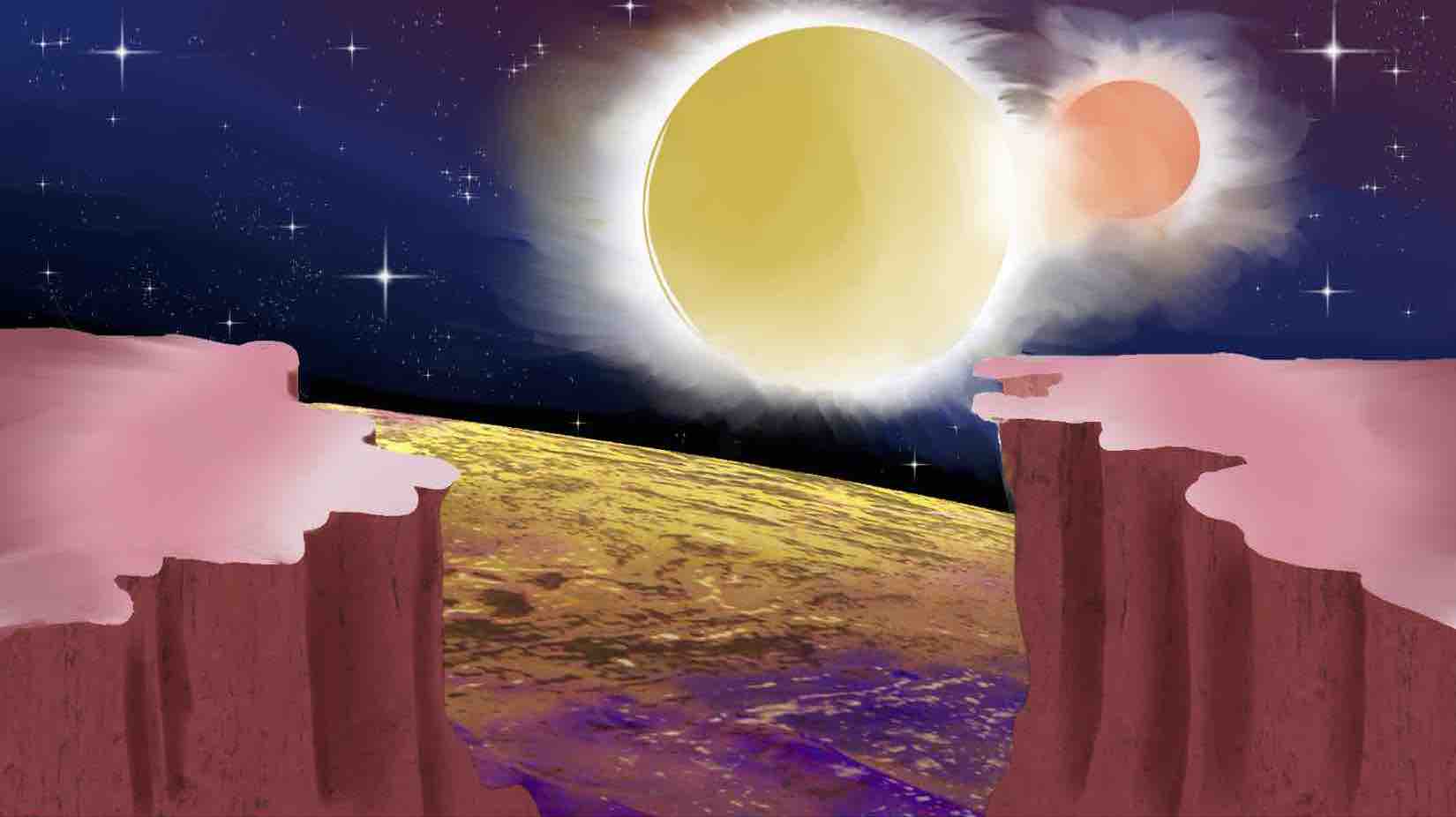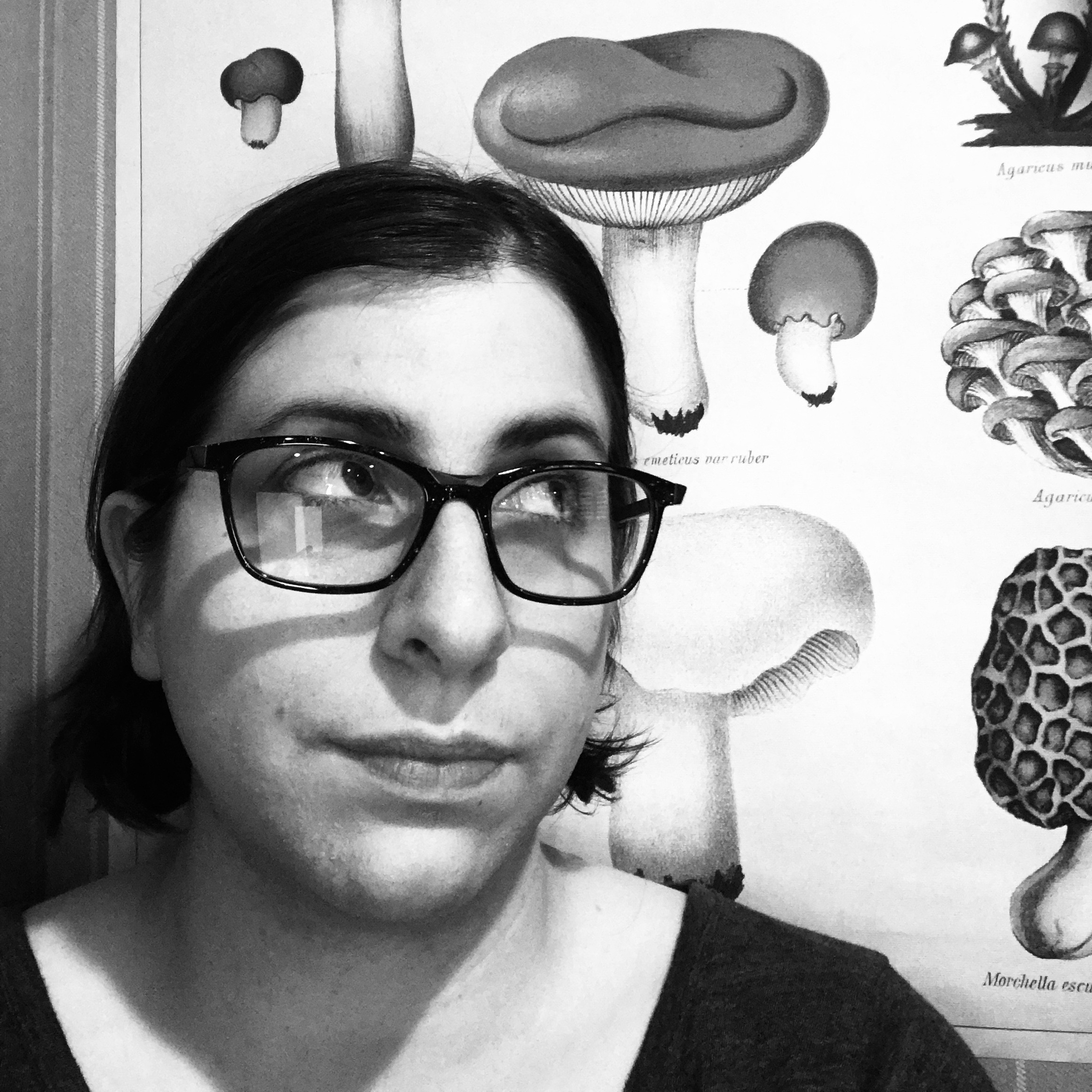Seeking binary sunsets
How common are planets with multiple suns? Erika K. Carlson speaks with researchers investigating the question. Illustrations by Adina Blackwood and Molly B. Wise.

Illustration: Adina Blackwood
Our sun and the eclectic family of planets around it started as one large cloud of gas and dust in space. About four and a half billion years ago, the cloud began to collapse, spinning out into a flattened disk like a tossed pizza. As the dusty cosmic pizza spun, the center got denser and hotter, scooping up gas from the swirling disk until it became the seething ball of plasma that is our sun.
Meanwhile, the leftover gas and dust circling around the infant sun formed planets. Some were massive rocky spheres whose gravity had slurped up gas into thick atmospheres and made them into gas giants. Others were smaller planets that managed to pick up just thin blankets of atmosphere to swaddle their rocky surfaces. And so our Solar System was born from one spinning, dusty disk in space.
But our Solar System is just one of myriad planetary systems of all shapes and sizes. One of our nearest astronomical neighbors is Alpha Centauri, a star system just four light-years away. Alpha Centauri is a binary star system, with two stars barely a billion miles apart circling each other once every 80 years in an unending dance.
“I would really love to know if there’s life elsewhere in the universe.”
Like the multiple lights on an airplane that look like a single star moving across the night sky, the stars in many of our galaxy’s binary systems are too close together for us to see as separate points of light from Earth, even with sophisticated telescopes. But thanks to a range of creative techniques, astronomers have found that binary and other multi-star systems are commonplace. Roughly half of stars similar in size to our sun have at least one stellar dance partner.
Meanwhile, astronomers have discovered thousands of planets outside the Solar System in the past decade. But most of these “exoplanets” are so far from us that it’s hard to tell whether the star systems they live in have one sun or more. This leaves astronomers questioning how common planets are in binary and multi-star systems. Does having a stellar partner affect the likelihood of planets forming around a star? Would the motions of stars in a multi-star system fling a planet away, marooning it in the lonely depths of space? And what could this mean for the possibilities of extraterrestrial life?
Now, astronomers like Courtney Dressing, an assistant professor at the University of California, Berkeley, are beginning to answer these questions with help from a space telescope called TESS — the Transiting Exoplanet Survey Satellite — which launched into orbit around Earth in April 2018. TESS should find thousands of new exoplanets over its two-year mission that orbit nearby stars. Dressing and other astronomers will use telescopes on the ground to study these nearby stars, checking whether they have stellar partners or they dance alone. Dressing’s work will help astronomers learn more about planets in multi-star systems by increasing the number of known multi-star planetary systems that astronomers will be able to study. Ultimately, Dressing wants to better understand where and how planets form and whether life can arise on them.
“I would really love to know if there’s life elsewhere in the universe,” Dressing says, “and I think this is one of the first steps that we need to do to make that happen.”
Are we alone?
Dressing has wondered whether we’re alone in the universe for as long as she can remember. As a teen, she explored the question from her parents’ backyard, reading Carl Sagan’s novel “Contact” by day and stargazing by night.
Originally, she wanted to search for answers in our own Solar System. As an undergraduate student, she worked on research projects measuring the numbers of small, round mineral lumps called “blueberries” found in rocks at Mars rover landing sites and studying satellite imagery of the Martian surface. “That seemed like the best chance we had at that time of detecting life elsewhere, because we had all these rovers going to Mars,” Dressing says.
Then, in 2009, the discovery of a new planet outside our Solar System caught Dressing’s attention. A team of astronomers led by David Charbonneau of Harvard University had found one of the smallest exoplanets yet orbiting a small star — one they called GJ 1214 b, a planet 42 light-years from Earth that sits somewhere between the Earth and Neptune in size and mass.
Up until this point, astronomers mostly hunted for alien planets using a technique called the radial velocity method. This method picks up the subtle wobbling of a star caused by a planet’s gravitational pull and is strongly suited to finding massive planets, like Jupiter, which tug harder than smaller planets. But Charbonneau’s team had used a different method capable of finding smaller exoplanets, called the transit method. So the much smaller GJ 1214 b was more similar to Earth than most exoplanets discovered so far.
They revealed our galaxy to be a place teeming with planets.
In the transit method, Charbonneau and his colleagues set their telescopes to watch stars for extended periods of time, looking for stars whose light dimmed regularly. This regular dimming was a sign that a planet might be passing in front of the star, blocking part of its light from our view. Compared with the radial velocity method, the transit method is better at finding smaller, less massive planets because even small planets can block measurable dips in brightness of the stars they orbit. That same year, NASA launched the Kepler space telescope, which was dedicated to searching for exoplanets using the transit method. In Earth orbit, Kepler avoided the Earth’s obscuring atmosphere, making it even more sensitive to small changes in stars’ brightnesses — and better at finding smaller planets.
“It was a big change from the era before,” Dressing says. “Now it seemed like from space we had the chance to start finding worlds that were more similar to the kinds of worlds that might have life on them.”
A college senior when Charbonneau’s team announced the discovery of GJ 1214 b, Dressing decided to go to graduate school in the astronomy department at Harvard. She began researching exoplanets with Charbonneau as her advisor.
Teeming with planets
Dressing and Charbonneau focused on exoplanets that Kepler found orbiting red dwarf stars. These red dwarves are smaller than our sun. The team found that small planets orbiting red dwarfs are extremely common. Dressing and Charbonneau calculated that almost all red dwarf stars have at least one roughly Earth-sized planet orbiting them. As many as 15 percent of red dwarfs might have Earth-sized planets in their habitable zones — where temperatures are right for liquid water on the planet’s surface.
The small stars Dressing studied make up the vast majority of stars in our galaxy — maybe roughly 75 percent, while sun-like stars might only be about 10 percent of stars or less. When Dressing and Charbonneau published their findings in a 2013 paper, they revealed our galaxy to be a place teeming with roughly Earth-sized planets.
“From her paper you could instantly estimate that there’s, you know, 30 billion Earth-sized planets in the habitable zone of stars in our galaxy,” says Jonathan Fortney, an astronomer and director of the University of California, Santa Cruz’s Other Worlds Laboratory, a group that studies planets both inside and outside our Solar System. “I think that was one of the most important papers in the past decade.”
While the Kepler space telescope stared at a single patch of sky for four years, TESS is scanning almost the entire sky over its two-year primary mission.
Illustration: Molly B. Wise
While Kepler opened our eyes to how common small planets are, it left some big challenges for more detailed studies of exoplanets. The planets Kepler found are in star systems that are up to 9,000 light-years from Earth and appear very faint to us. To study these faint systems in detail, exoplanet researchers would need to use some of the world’s largest telescopes for long stretches of time. That’s not possible, because many researchers compete for time on these premier telescopes.
So exoplanet researchers decided to look for exoplanets orbiting closer, brighter star systems, which they could study from the ground more easily. In April 2018, NASA launched a new exoplanet-hunting space telescope, TESS, that is looking for exoplanets orbiting these close, bright stars. Since its launch, TESS has been orbiting the Earth and searching the sky for exoplanets using the transit method, the same technique that Kepler used. But unlike Kepler, which stared at a single patch of sky for four years, TESS is scanning almost the entire sky over its two-year primary mission. Compared with Kepler, it will find many more planets that orbit nearby stars — most will be within 1,000 light-years of Earth.
The closer a star system to Earth, the easier it is for astronomers to see whether the system houses one star or multiple stars. So TESS’s discoveries of new, nearby exoplanets should ultimately lead astronomers to find more exoplanets in multi-star systems.
Two alien suns
Dressing and her research group at UC Berkeley are at the forefront of this effort. They’re working to find out whether the new exoplanets discovered by TESS are housed in single or multi-star systems. This work will allow astronomers to start answering questions they couldn’t tackle in the Kepler era: How common are planets in multi-star systems, and how do planetary systems’ properties depend on whether there is more than one star in the system?
How likely planets are to form in binary and multi-star systems relates to the larger question of planetary habitability — where planets can form and possibly support life. Recent research has shown that a stellar partner can affect the location of a star’s habitable zone, for example. And it may be harder for life to form on exoplanets in binary star systems. For instance, colliding streams of charged particles emitted by the two stars in a binary system might disrupt the formation of a protective atmosphere that would otherwise guard a nearby planet’s life forms from harmful radiation.
“This is about trying to put our own Solar System in context,” says David Ciardi, an astronomer at the California Institute of Technology and one of Dressing’s collaborators. “The sun is a single star. And so as a result, that probably played a role in how our Solar System formed. Which maybe be very different than if there was another star in the system.”
To determine how common planets are in multi-star systems and find multi-star planetary systems to study in detail, Dressing is using a high-resolution imaging technique on a telescope at Lick Observatory on Mount Hamilton, about 70 miles southeast of UC Berkeley’s campus. The technique, called adaptive optics, lets Dressing image binary star systems in great detail. She can use it to reveal that a binary star system that looks like a single light source to TESS actually harbors two separate points of light — two suns in an alien planetary system. Armed with adaptive optics, Dressing will find which of the planets TESS discovers are in multi-star systems.
“This is about trying to put our own Solar System in context.”
A clear image of two stars in a binary pair is not, unfortunately, something that Dressing and her team got to see on the night of Jan. 21, 2019. It was the third night of a five-night observing run on Lick Observatory’s three-meter-wide Shane Telescope, and bad weather had kept them from getting much usable data so far.
The temperatures at Lick Observatory were barely above freezing. The night before, it had snowed on the mountain and they couldn’t even open the telescope dome to try to make any observations. Dressing and four of the students working with her waited out the poor weather from the relative comfort of a small remote observing room on UC Berkeley’s campus. They were crowded on all sides by a sofa, a small fridge, a long desk adorned with an array of six computer monitors and a TV screen mounted on one wall. The screen showed a video conference with Lick Observatory staff members who operated the telescope from a control room at the observatory.
The observatory staff carefully watched the weather conditions — temperature, wind speed and humidity — to see when it might be safe to open the dome and expose the telescope to the elements. At any moment when the weather was good enough to merit a shot at getting observations, Dressing’s team sprang into action.
“Who wants to drive?” Dressing would ask, gesturing toward the six monitors that control the camera attached to the telescope 70 miles away.
On a good night, Dressing’s team can photograph 20 to 30 of the star systems that TESS searches for planets. The team estimates that, given enough time, it could image more than 4,000 of these potentially planet-hosting systems from Lick Observatory to check whether the systems have one or more stars.
Myriad arrangements
Dressing’s finds would help astronomers like Ji Wang of Ohio State University and Adam Kraus of the University of Texas at Austin better understand when and how planets can form in binary star systems. Wang and Kraus have each been studying planets in binary star systems. Overall, the pattern seems to be that a system of two stars close together discourages planets from forming around either star, possibly by sucking up the star-forming disk’s excess gas and dust from which a planet would have formed.
“Where are there planets? Where are there potentially habitable planets?”
But in some cases, planets can form in an orbit around a pair of stars, like the planet Tatooine in “Star Wars,” if the stars are far enough away from the planet. Planets can also form around individual stars in a binary system if the two stars in the system are far enough apart. Studying more multi-star planet systems would help astronomers like Wang and Kraus pin down details of where and how planets can form in these systems.
“It ultimately comes back around to asking, ‘Where are there planets? Where are there potentially habitable planets?’” Kraus says. He adds that a lot of alien species in science fiction franchises like “Avatar” and “Star Trek” are said to live in star systems we know are multi-star systems.
“We might have to go back and retcon a lot of sci-fi if it turns out all these places can’t have planets,” he jokes.
Even in just our corner of the galaxy, millions of stars and star systems abound. Across our entire galaxy, there are hundreds of billions of stars. And our Milky Way is just one of possibly hundreds of billions of galaxies that stretch throughout our known universe. Out in the vast reaches of space are countless planetary systems in a myriad arrangements, known and unknown.
To exoplaneteers like Dressing, unraveling these many arrangements is key to understanding the diversity of planets possible, finding where life might arise and mapping our own place in the universe.
“I want to understand these planets!” Dressing exclaims, “and to know them individually as worlds.”
© 2020 Erika K. Carlson / UC Santa Cruz Science Communication Program
A version of this article originally appeared in Discover magazine’s March/April 2020 issue and on discovermagazine.com.

Erika K. Carlson
Author
B.A. (physics) Pomona College
M.S. (astronomy) University of Wisconsin, Madison, (science communication) University of California, Santa Cruz
Internships: Santa Cruz Sentinel, Science Magazine, SLAC National Accelerator Laboratory, Quanta Magazine
When I was eleven years old, I read a magazine story about the science of flavor. An illustration accompanying the story showed a large, pink milkshake brimming with the names of all the chemicals that make up strawberry flavoring. To this day, I can’t look at a strawberry milkshake without picturing a long list of chemical compounds.
Studying physics and astronomy also changed the way I see the world. Every shadow and reflective surface became an opportunity to ponder how light behaves. Each night sky offered a new chance to wrap my mind around the vast scales of our universe.
As a science writer, I now want to highlight the extraordinary nature of the ordinary world around us—to do for others what that strawberry milkshake did for me.

Adina Blackwood
Illustrator
B.A. (visual and performing arts) California State University, San Marcos
Graduate Certificate (science illustration) California State University, Monterey Bay
Internship: Far West Fungi (Moss Landing, California)
Adina Blackwood is a science illustrator and graphic designer from San Francisco, California. Her style can be described as Old World with a modern and fantastical graphic flair. Her work invites the viewer to see the unsung “champignons” of the natural world. Her mission is to share the wild splendor and natural beauty of our ecosphere.
Adina spends her allotted free time photographing the world around her, collecting bones, shells, and feathers, listening to Nordic chants, and daydreaming about fantastical creatures and mushrooms. With every flick of her pen and swish of her stylus, she is able to show how deep the roots of art and science can go.

Molly B. Wise
Illustrator
B.F.A (illustration) California State University, Fullerton
Graduate Certificate (science illustration) California State University, Monterey Bay
Molly B. Wise is a California born illustrator and designer. She draws much of her inspiration from the dichotomy of beauty and chaos that dictates the natural world. Molly received her Bachelor of Fine Arts in Illustration from California State University, Fullerton, where she realized her passion for capturing movement and creating a kinetic sense on paper. In her graphic work, she aims to communicate through elegant design and color, incorporating simplicity and organic structure. Molly considers herself a generalist at present, wanting to expand her breadth of knowledge and technique and willing to accept most artistic challenges.